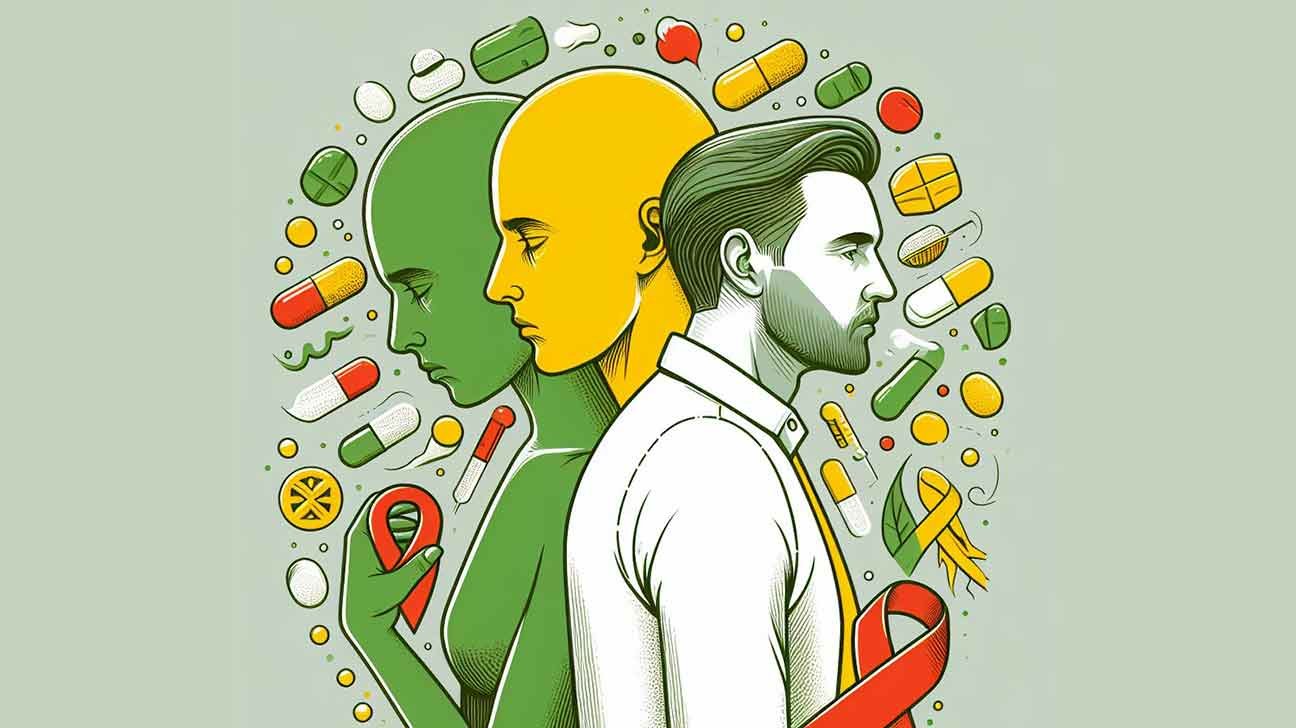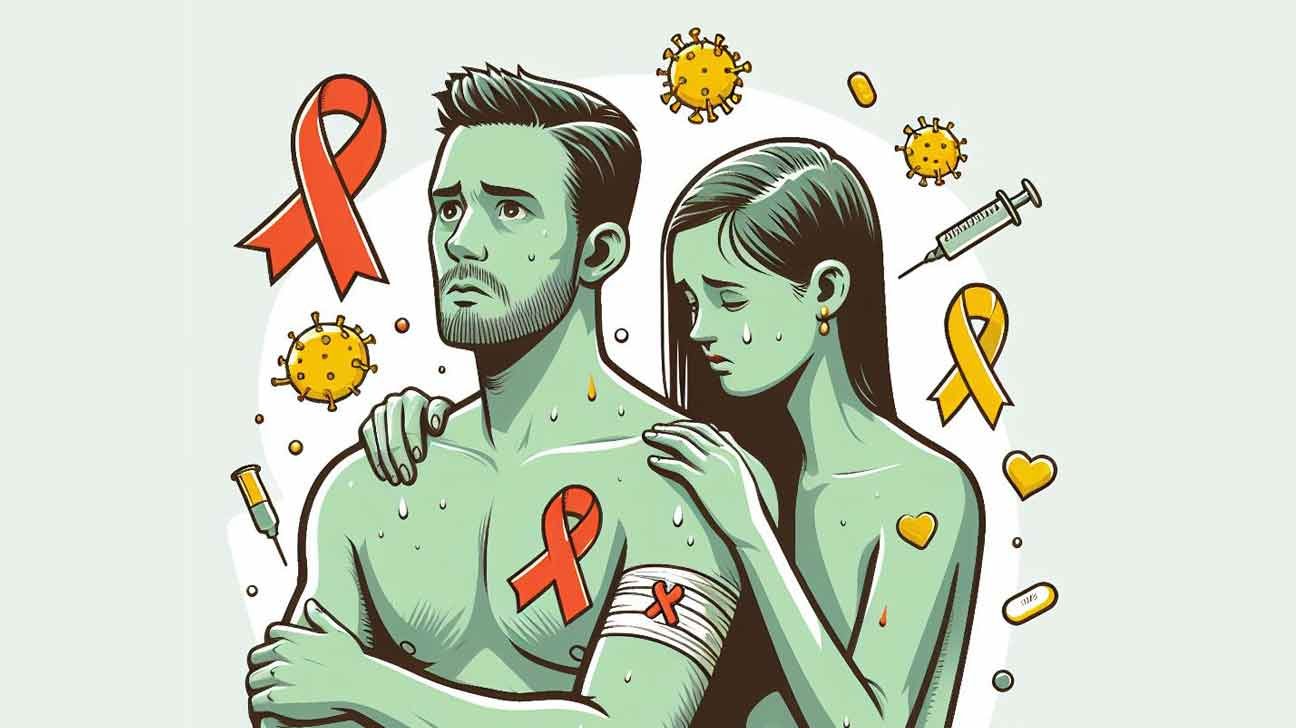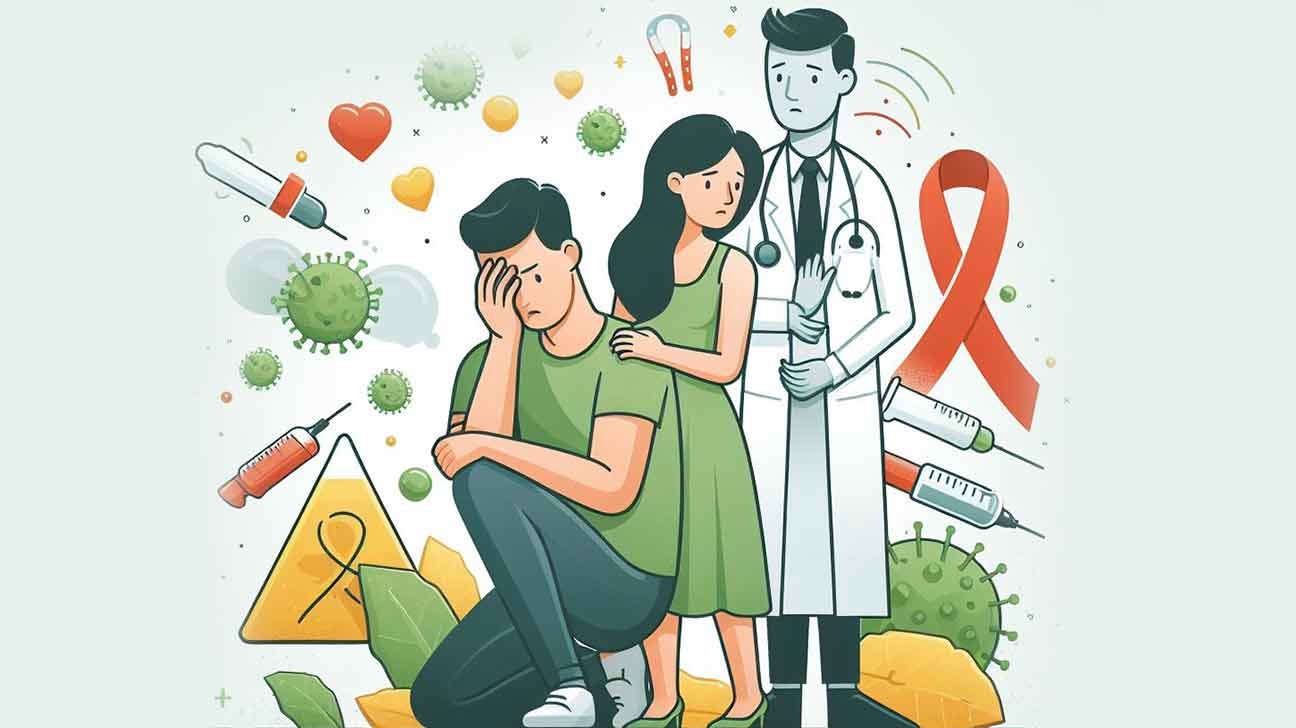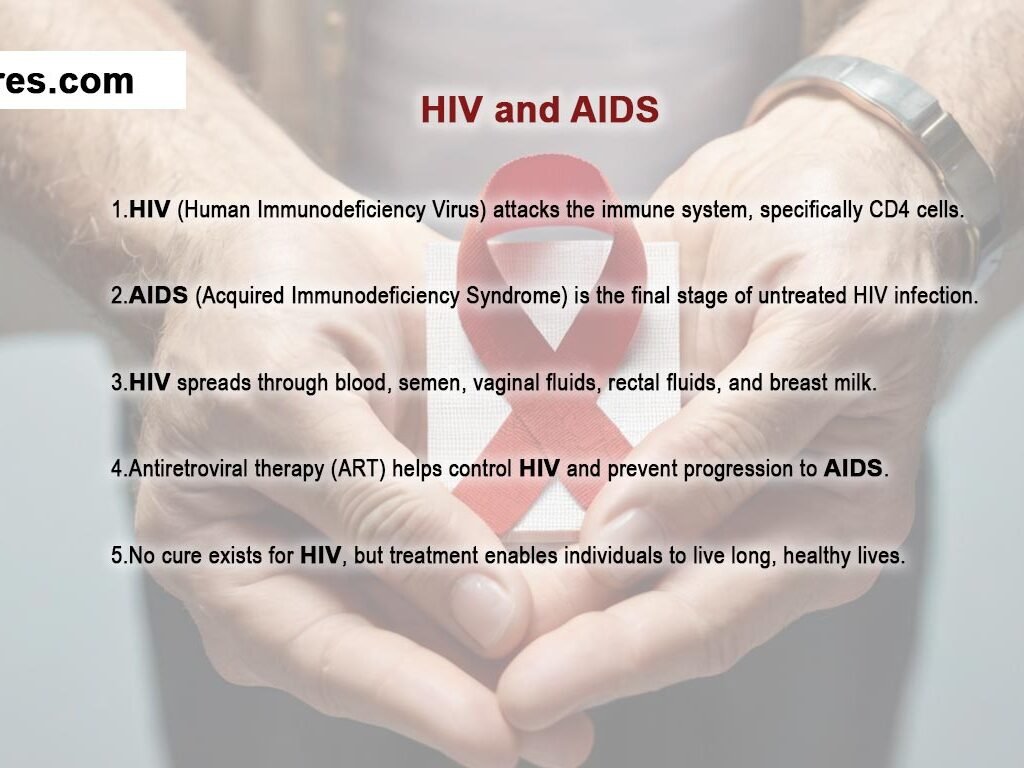The HIV Awareness Ribbon is a widely recognized symbol used to promote awareness, show support, and reduce the stigma associated with Human Immunodeficiency Virus (HIV) and Acquired Immunodeficiency Syndrome (AIDS). Here’s a comprehensive overview of the HIV awareness ribbon:
Design and Appearance
- Color: The ribbon is typically red, symbolizing love, passion, and the fight against HIV/AIDS.
- Shape: It follows the classic ribbon design, which is a looped band tied into a bow.
Symbolism and Meaning
- Red Color: Represents the blood, the primary medium through which HIV is transmitted, and signifies the urgency and severity of the epidemic.
- Ribbon Shape: Universally recognized as a symbol for support and solidarity with those affected.
History and Origin
- The use of ribbons as symbols for various causes dates back to the early 20th century, but the specific red ribbon for HIV/AIDS gained prominence in the early 1990s.
- 1991: The red ribbon was officially adopted during World AIDS Day (December 1) to raise awareness about HIV/AIDS.
- The symbol quickly became a unifying emblem for global efforts to combat the disease, support those living with it, and promote prevention and education.
Usage and Campaigns
- World AIDS Day: Observed on December 1st each year, the red ribbon is prominently displayed in events, educational campaigns, and memorials.
- Fundraising Events: Marathons, concerts, and community gatherings often feature the red ribbon to symbolize support and raise funds for HIV/AIDS research and services.
- Personal Wear: Individuals wear the ribbon on clothing, accessories, or as tattoos to show solidarity, support loved ones, or signify their own experiences with HIV/AIDS.
- Awareness Materials: The ribbon is featured in posters, flyers, digital media, and merchandise to spread information and encourage dialogue about HIV prevention and treatment.
Impact and Importance
- Reducing Stigma: The widespread recognition of the red ribbon helps normalize conversations around HIV/AIDS, reducing fear and misconceptions.
- Education: Serves as a visual reminder to educate the public about transmission methods, prevention strategies, and the importance of testing.
- Support Network: Creates a sense of community and support for those affected, fostering connections between individuals, healthcare providers, and advocacy groups.
- Advocacy: Empowers activists and organizations to advocate for policies, funding, and resources necessary to address the HIV/AIDS epidemic effectively.
Global Recognition
- The red ribbon transcends cultural and national boundaries, making it a universal symbol in the fight against HIV/AIDS.
- Partnerships: Collaborates with international organizations like UNAIDS, the World Health Organization (WHO), and various non-profits to amplify its message and reach.
Related Symbols and Initiatives
- Rainbow Ribbon: Sometimes used to represent the intersection of HIV/AIDS with LGBTQ+ communities, emphasizing the disproportionate impact on these groups.
- Specific Campaigns: Variations of the ribbon may be used to highlight particular aspects, such as prevention (e.g., safe sex practices) or treatment advancements.
How You Can Support
- Wear the Ribbon: Show your support by wearing a red ribbon or incorporating the symbol into your attire during awareness months.
- Participate in Events: Join local or virtual events aimed at raising awareness and funds for HIV/AIDS initiatives.
- Educate Yourself and Others: Learn about HIV/AIDS and share accurate information to combat myths and misinformation.
- Support Organizations: Donate to or volunteer with organizations dedicated to HIV/AIDS research, support services, and advocacy.
Conclusion
The HIV awareness ribbon is more than just a symbol; it embodies the collective effort to fight against HIV/AIDS, support those affected, and strive for a world free from the stigma and challenges posed by the virus. By understanding and promoting the significance of the red ribbon, individuals and communities contribute to meaningful change and progress in the global health landscape.

Detail Information Of HIV
HIV, or human immunodeficiency virus, attacks the immune system. Untreated, it can lead to AIDS, a severe immune deficiency state.
An introduction to HIV must confront the virus’s impact on health and its global significance. Although a cure remains elusive, advances in treatment have transformed HIV from a fatal diagnosis to a manageable chronic condition. Around 38 million people worldwide live with HIV, highlighting the importance of access to accurate information and healthcare services.
Education on prevention, early detection, and treatment options is crucial. Safe practices, regular testing, and adherence to antiretroviral therapy empower individuals to lead healthier lives. Governmental and non-profit organizations work tirelessly to combat the spread of human immunodeficiency virus and support those affected, reinforcing the message that with the right care and support, people living with HIV can maintain a high quality of life.
Busting Hiv Myths
The battle against HIV is not just about medical advancements; it’s also about overcoming misinformation. The myths surrounding HIV create barriers to prevention and treatment, fueling stigma and discrimination. In this section, we aim to dismantle some of the most common misconceptions about HIV, using facts to promote awareness and empathy.
Common Misconceptions About Hiv
Let’s address some myths that often circulate about HIV:
- Human immunodeficiency virus is a death sentence: This is no longer true. With current treatments, many live long, healthy lives.
- You can get HIV from touching: HIV cannot be transmitted through casual contact like hugging or shaking hands.
- Human immunodeficiency virus only affects certain groups: Anyone can contract HIV, regardless of age, sex, or ethnicity. It’s the behaviors, not the groups, that influence risk.
Counteracting Hiv Stigma
To fight stigma, we must first understand it. Stigma stems from fear and misinformation. Below are steps to reduce HIV-related stigma:
- Learn and share accurate information to dispel myths.
- Show support for people living with HIV, fostering a community of inclusion and understanding.
- Challenge discriminatory behaviors and language when you see them.
Together, we can create a world where everyone, regardless of their HIV status, is treated with dignity and respect.
Key Facts About Hiv
Human Immunodeficiency Virus (HIV) affects millions worldwide. Understanding HIV is crucial for preventing transmission and managing the condition in individuals who have been diagnosed. Below are facts that shine a light on this global health issue.
Transmission Realities
HIV cannot be transmitted through casual contact, such as shaking hands, hugging, or sharing dishes. Transmission can occur through specific activities.
- Sexual contact without protection is a common transmission route.
- Sharing needles or syringes can transmit the virus.
- Pregnant women can pass the virus to their babies during childbirth or breastfeeding.
- Exposure to HIV-infected blood, often in healthcare settings, presents risks.
Advancements In Treatment
The medical community has made significant progress in HIV treatment. This has transformed HIV from a fatal condition to a manageable chronic disease.
| Year | Advancement |
|---|---|
| 1990s | Introduction of antiretroviral therapy (ART). |
| 2000s | Improved drug regimens with fewer side effects. |
| 2010s | Pre-exposure prophylaxis (PrEP) becomes available. |
| 2020s | Long-acting injectable treatments provide new options. |
With regular treatment, many people living with HIV lead full, healthy lives. Early detection and consistent care are vital for long-term health outcomes.
Prevention Strategies
Fighting HIV requires effective strategies to stop the spread. Understanding and implementing prevention tactics are crucial.
Safer Sex Practices
Practicing safer sex is the cornerstone of HIV prevention. The following are essential:
- Always use condoms or dental dams during intercourse.
- Choose lubricants that don’t damage condoms.
- Limit the number of sexual partners to reduce risk.
- Engage in mutual monogamy where both partners are tested for HIV.
- Test regularly for HIV and other sexually transmitted infections (STIs).
- Consider Pre-Exposure Prophylaxis (PrEP) if at high risk.
- Post-Exposure Prophylaxis (PEP) can help after potential exposure.
Needle Exchange Programs
Needle exchange programs are vital for those who use injectable drugs. They offer:
- Clean needles to reduce the risk of HIV transmission.
- Safe disposal of used needles to protect the community.
- Access to HIV testing and counseling services.
- Resources for drug treatment programs to encourage recovery.
The Evolution Of Hiv Medicine
HIV medicine has transformed over decades. The journey from early treatments to modern antiretroviral therapy marks a significant scientific advancement. People with HIV now lead healthier, longer lives. This progress reflects the tireless work of researchers and healthcare professionals worldwide.
Early Treatments
Early Treatments
The first HIV treatments sought to slow the virus’s spread. During the early 1980s, treatment options were limited and largely ineffective. Fear and stigma surrounded the disease.
- AZT (zidovudine) became the first approved HIV medication in 1987.
- Early drug regimens were complex, with severe side effects.
- These treatments offered limited benefits and did not stop disease progression.
As researchers gained better understanding, medications improved. The 1990s saw the introduction of new classes of drugs. These targeted different stages of the HIV life cycle.
Modern antiretroviral therapy
Modern Antiretroviral Therapy
The advancement to modern antiretroviral therapy (ART) was a turning point in HIV treatment. Today’s ART is more effective, with fewer side effects.
- Combination therapy, known as HAART, emerged in the mid-1990s.
- Current treatments often involve a single pill, taken daily.
- These regimens suppress the virus to undetectable levels.
- This prevents progression to AIDS and reduces transmission risks.
| Year | Development |
|---|---|
| 1987 | Approval of AZT |
| 1990s | Introduction of new drug classes |
| Mid-1990s | Emergence of HAART |
| 2000s – Present | Refinement of ART to single-pill regimens |
Thanks to ART, HIV-positive individuals enjoy greater health and quality of life. The focus now includes not just survival, but also thriving with HIV.
Diagnosis And Early Intervention
Knowing your HIV status through diagnosis is the crucial first step towards maintaining a healthy life and preventing the transmission of HIV. Once diagnosed, early intervention with the right treatment can greatly increase the quality of life and life expectancy for individuals living with HIV.
Importance Of Testing
Getting tested for HIV is a must for everyone. Here’s why:
- Know Your Status: It is vital to know if you have HIV.
- Early Detection: Early detection can improve treatment outcomes.
- Prevent Spread: Knowing your status helps prevent passing the virus to others.
Many places offer free, fast, and confidential testing. Don’t wait!
Starting Treatment
Beginning treatment soon after diagnosis is critical. Here’s what you should know:
- Consult a Doctor: Talk to a healthcare provider for the best treatment plan.
- Start Antiretroviral Therapy (ART): ART helps keep the virus in check and can lead to a near-normal life expectancy.
- Stay Adherent: Following your treatment regimen is essential.
Starting treatment early helps keep your immune system strong.
Living With Hiv
Life doesn’t stop with an HIV diagnosis. With the right steps, anyone can live a full, healthy life. This post explores everyday management and the importance of support systems for those living with HIV. Learn how to navigate day-to-day challenges and build a network of support.
Managing Day-to-day Life
Living with HIV requires attention to your health and wellbeing:
- Adhere strictly to treatment: Take medication as prescribed.
- Nutritious diet: Focus on a balanced, healthy diet.
- Regular exercise: Keep your body strong.
- Avoid certain foods: Stay away from undercooked eggs and meat.
- Rest well: Ensure plenty of sleep.
| Aspect | What to Do |
|---|---|
| Medical Care | Regular check-ups |
| Mental Health | Counseling as needed |
Follow these steps daily for the best outcomes.
Support Systems
A strong support system is crucial:
- Talk to family and friends.
- Join HIV support groups.
- Seek professional mental health assistance if needed.
Remember, you’re not alone: Many communities and online forums offer empathy and advice. Lean on them during tough times.
Mental Health And Hiv
HIV diagnosis often brings a variety of emotional challenges. The mental health implications are as critical as the physical struggles. Supporting mental well-being is crucial for those living with HIV.
Emotional Responses To Diagnosis
Finding out you are HIV positive can stir up many feelings. Some common reactions include:
- Shock at the initial news
- Sudden fear of the future
- Anger or disbelief
- Anxiety about health and relationships
It’s important to deal with these emotions. Talk to a counselor, join a support group, or connect with others who understand.
Long-term Mental Health Care
Managing HIV involves ongoing attention to mental health. Maintaining a healthy mindset promotes better health outcomes. Here’s how to support long-term mental health:
| Method | Details |
|---|---|
| Professional Support | Therapists specialized in chronic illness can provide valuable coping strategies. |
| Medication | Antidepressants or anti-anxiety drugs may be prescribed if needed. |
| Lifestyle Changes | Regular exercise and a balanced diet can improve mood and well-being. |
| Peer Networks | Support groups offer a platform to share experiences and receive encouragement. |
Remember, seeking help is a sign of strength, not weakness. Regular check-ins with mental health professionals can greatly benefit those living with HIV.
Hiv And Relationships
Building and maintaining relationships while living with HIV poses unique challenges. Fear, stigma, and misinformation can impact personal connections at their core. Love and support are key. It’s vital to approach relationships with honesty, responsibility, and care for each other’s well-being. This section addresses how to navigate the delicate balance of personal disclosure and protection, alongside the hopes of starting a family.
Disclosing Your Status
Disclosing Your Status
Sharing your HIV status with a partner is a courageous step. It is a personal decision that requires trust. When you disclose, choose a private and comfortable environment. It’s also wise to have resources ready, to answer any questions your partner might have.
- Be prepared for different reactions.
- Explain how you manage your health.
- Reassure them of the steps you take to prevent transmission.
Protection And Conception
Protection And Conception
Protecting your partner’s health and your own is part of a responsible relationship. Safe sex practices, such as consistent condom use, and considering PrEP for the HIV-negative partner are effective strategies.
Conceiving a child while one partner is HIV-positive entails additional planning. With medical advancements, it’s possible to have a healthy pregnancy. Measures include Antiretroviral Therapy (ART) for the HIV-positive partner to maintain an undetectable viral load.
- Consult with health care providers for the best approach.
- Explore options like sperm washing and assisted reproduction.
- Stay informed about new ART developments.
Global Hiv Epidemic
The world is in an ongoing battle against HIV, a virus that has claimed millions of lives and continues to affect many more. Despite significant progress, the HIV epidemic remains a public health challenge globally. It is vital to recognize the scope of this issue while promoting awareness and taking action towards prevention and treatment.
Statistics Around The World
Global incidence rates showcase the harsh reality of the HIV epidemic. Nations around the world report varied numbers, reflecting the impact of this virus:
- Sub-Saharan Africa: Remains the most affected region, accounting for a large majority of the world’s HIV cases.
- Asia & the Pacific, Eastern Europe, and Central Asia: Show worrying trends with increasing infection rates.
- Western and Central Europe, North America: Maintain lower prevalence but face issues with undiagnosed and late-diagnosed cases.
| Region | New Infections | Deaths (Annual) |
|---|---|---|
| Sub-Saharan Africa | 1 million | 440,000 |
| Asia & Pacific | 310,000 | 170,000 |
| Eastern Europe & Central Asia | 130,000 | 58,000 |
International Initiatives
- UNAIDS: Leading the global effort to end AIDS as a public health threat by 2030 as part of the Sustainable Development Goals.
- The Global Fund: A partnership designed to accelerate the end of AIDS, tuberculosis, and malaria as epidemics.
- PEPFAR: The U.S. President’s Emergency Plan for AIDS Relief continues to save lives and has made significant impact in reducing the burden of HIV.
International collaboration is crucial to control and ultimately reverse the HIV epidemic. Continued support, increasing resources and universal access to preventive measures and treatments are the keys to success in this global fight.
Future Of Hiv Research
The fight against HIV has been transformative over the past decades, with groundbreaking advancements in treatment and prevention. Yet, the journey does not end here. The future of HIV research is vibrant with promise, aiming at more ambitious targets: a cure and a vaccine. Researchers globally are relentlessly pushing the boundaries of science to bring an end to this epidemic, ensuring the next chapters in the HIV narrative are filled with hope.
Vaccine Development
Vaccine research stands as a cornerstone in the quest to eradicate HIV. The idea is simple yet powerful: teach the body to defend itself against the virus before it can take hold. With years of research, this dream inches closer to reality.
- Multiple vaccine candidates are currently undergoing clinical trials.
- Advancements in molecular science have improved our understanding of the virus’s structure.
- Novel approaches, like mRNA technology, show promise following their success in COVID-19 vaccines.
Cure Research
While antiretroviral therapy can control HIV, a cure eludes us. Scientists are exploring several avenues to achieve this.
- Gene editing tools, like CRISPR-Cas9, could potentially cut the virus out of DNA.
- ‘Shock and kill’ strategy aims to wake up dormant HIV and eliminate it.
- Stem cell transplantation might offer clues following successful cases in select patients.
Frequently Asked Questions On Hiv
Can I Live A Normal Life With Human immunodeficiency virus?
Yes, individuals with HIV can lead a normal life with proper treatment and care, closely managing their health. Regular medical checkups and adherence to prescribed medication are crucial.
What Happens If You Have Human immunodeficiency virus?
Having HIV, the virus damages your immune system, increasing risk for severe infections and certain cancers. Early diagnosis and consistent treatment can manage the virus effectively.
Can I Live With Hiv Without Medication?
Living without HIV medication can significantly reduce life expectancy and lead to severe health complications.
What Should Hiv Positive Avoid?
HIV-positive individuals should avoid raw or undercooked meats, unpasteurized dairy, raw eggs, and exposure to other infections.
What Are Symptoms Of Human immunodeficiency virus Infection?
HIV initially causes flu-like symptoms such as fever, sore throat, and fatigue which can be mistaken for other illnesses. Advanced stages might lead to severe immune deficiency and opportunistic infections.
Conclusion
Understanding Human immunodeficiency virus is crucial, as lives and well-being hinge on awareness and action. Staying informed about prevention, treatment options, and living with the virus is essential. Remember, early detection and adherence to treatment can lead to a healthier, longer life.
Cherish every stride in science and community support, and always consult healthcare professionals for guidance on managing HIV effectively. Let’s continue to combat stigma with knowledge and compassion.





It’s actually a nice and helpful piece of info. I am happy that you shared this helpful information with us. Please keep us up to date like this. Thanks for sharing.